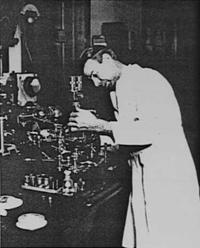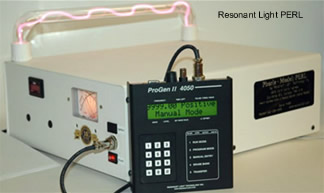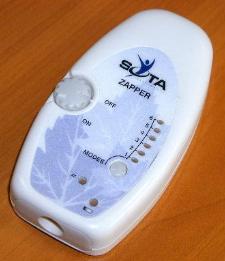Electrical and Frequency Effects on Pathogens
In the early 1900s, Royal Rife discovered that certain lower life forms could be "devitalized" by subjecting them to certain frequencies produced by an electrical apparatus. He used a combination of AC and DC power to do so. He used a powerful dark field microscope, another device he perfected, which allowed him to watch the effects of his frequency generator on live viruses, bacteria, paramecium, and other potential pathogens. He watched as they were devitalized in a number of ways, either losing their motility, pleomorphing into a different (and hopefully nonpathogenic) form, or actually bursting. Unfortunately, most of his work and the exact design of his frequency generator were lost. This story is detailed in a book called The Cancer Cure that Worked by Barry Lynes.
 In a small clinical study during Rife's time, his frequency generator reportedly had a 100% cure rate for the types of cancers that were investigated - sarcomas and carcinomas. He also had a perfect cure rate for other serious diseases of the time, like tuberculosis. The tale of how this work was almost lost to mankind due to fledgling pharmaceutical companies and the AMA is a story for the conspiracy theorists.
In a small clinical study during Rife's time, his frequency generator reportedly had a 100% cure rate for the types of cancers that were investigated - sarcomas and carcinomas. He also had a perfect cure rate for other serious diseases of the time, like tuberculosis. The tale of how this work was almost lost to mankind due to fledgling pharmaceutical companies and the AMA is a story for the conspiracy theorists.
Rife's dark field microscope was also an innovation far ahead of its time. It allowed him to view even the tiniest viruses while they were still alive by staining them with light, unlike today's electron microscopes for which the sample must be "fixed" which kills the pathogen being viewed. With this microscope, he saw and reported instances of pleomorphism, which is when an organism mutates, as when a bacterium mutates to a fungal-type lifeform. This was also reported by Bechamps, another early microscopy pioneer, but is still considered anathema to the conventional medical establishment, even though complementary modern researchers working with dark field microscopes have clear proof that it occurs and are willing to show anyone who cares to look.
The exploration of this phenomenon and that of frequency and other electrical effects on pathogens will likely one day be common. However, there is little profit, and hence motivation, for large corporations to research electrical modalities to treat disease, especially with devices that one can build oneself. This is not to mention the political and legal pressure that comes from government agencies pressured by organizations that have the most to lose from the development of such treatments, like pharmaceutical companies, which may be a much larger factor. It will only come about when so many people know about this treatment, use it, and are more successful using it than with conventional modalities that it may become the preferred method to treat some diseases due to cost, safety, and efficacy. Eventually, doctors will have to lobby the AMA and FDA to allow them to use these devices to better perform their services without fear of persecution and prosecution. With the entrenched medical bureaucracy in the United States and other countries, however, this may take a century or more.
In the meantime, people will perform their own bit and piece research for diseases that conventional medicine has little luck in treating successfully. Luckily, due to the internet, this can occur at a much faster rate as people the world over share results. Plus, in many developing countries there is not yet political pressure hampering this research, which could speed results.
Another factor that may accelerate progress in this field is the vast amount of commercial applications that exist for this technology which are outside the government-protected field of internal medicine. There is a (rather expensive) "pimple zapper" which uses a single sharp electrode in one hand (and the box in the other) advertised which claims to locally kill bacteria which can cause eruptions. A salmonella detector was once developed for egg processing lines which stimulates eggs with audio waves and listens for salmonella resonance. Other potentially profitable applications are as a safe pesticide in homes (and perhaps farms) and as a disinfectant.
Since the early 1990s, James Bare has been working to recreate Rife's work, and has a book and video showing how to build a generator which approximates Rife's. His video shows pathogens succumbing to the effects of his generator, usually bursting or hemorrhaging from the field effects from the transmitter, which is 5 or more feet away.
Bare’s Rife device generates a 27 MHz AC waveform and combines it with a DC waveform at varying frequencies, usually in the audio range. The waveform excites a plasma tube from which the power is transmitted. The high frequency penetrates the body efficiently, but the antipathogenic action is thought to be mostly the harmonics caused by the DC portion.
The Rife-Bare device will not generate high enough frequencies to match those discovered by Hulda Clark (in the DC portion) to kill pathogens directly. It must use the harmonics of the frequency generator and as such produces a DC waveform which produces enough harmonics to generate them.
This is an inexact science at this time, and due to fluctuations in construction, equipment, tube variations, operating technique, results differ from those building and using the devices, although most admit when they follow Bare's instructions to the letter, they have the best results. Once the device is constructed, cautious experimenters test it on cultures of bacteria, molds, paramecium, etc, to more assure the device produces a useful wave.
The people working with Rife/Bare generators report that it is easy to tell when a frequency generator is causing harmful effects since pain will be felt. They have done experiments on lab rodents and reported that they will not tolerate harmful frequencies without trying to escape. Even so, incautious experimentation with high voltage devices can cause damage or even death, so it is critical that one thoroughly understands the ramifications of dealing with these types of bioelectronics.
 The Rife-Bare generator is one of the few types of frequency treatments where the subjects do not come in contact with the device, and some report it works as much as 100 feet or more away (killing fungus). Other methods that people use to apply frequency to the body include coils, pads, handholds, and other contact applicators. Coils of wire can be stimulated with a frequency and produce a field which will penetrate the body, and some use this method to treat Lyme disease. Pads or handholds can be used to apply voltage directly to the body.
The Rife-Bare generator is one of the few types of frequency treatments where the subjects do not come in contact with the device, and some report it works as much as 100 feet or more away (killing fungus). Other methods that people use to apply frequency to the body include coils, pads, handholds, and other contact applicators. Coils of wire can be stimulated with a frequency and produce a field which will penetrate the body, and some use this method to treat Lyme disease. Pads or handholds can be used to apply voltage directly to the body.
One person reported that he caused possibly permanent nerve and lymph node damage to himself by applying voltage using a wire coil attached to a function generator, amplified to 60 volts, and at tapeworm frequencies as published by Clark. He says he had a tapeworm in a lymph node which "bubbled up" when subjected to the field, killing it but damaging his lymph node.
Human body cells have a resonant frequency at about 1000 KHz, and any strong DC modulated signal over 330 KHz produces harmonics of significant amplitude in this frequency range. AC signals do not produce these harmonics, so are probably safer to use, but also do not work nearly as well when used in a frequency-unspecific manner.
Hulda Clark uses an AC frequency generator with handholds to kill pathogens in the body. Using a device she developed called a syncrometer, she determined the resonant frequencies of many potential pathogens in the body and proceeded to kill them with an AC frequency generator. This list is published in her book called The Cure for all Diseases. The only problem with this method is that the pathogen that is causing an illness must be accurately identified before treatment, so that the correct frequency can be used. To run through the entire list of pathogens and dial in the frequencies for all of them for a minimum 3 minutes each requires many hours.
Clark then developed a “zapper.” It is a single frequency generator which produces DC square waves at about 30 KHz. The lowest frequency given on her list of pathogens is about 70 KHz and goes up beyond 1MHz. Yet, she reports that the DC wave kills many different pathogens in the body. She once speculated that this was from the positive offset DC voltage on the body, but some thought it more likely that the bugs were still dying from frequency effects from the harmonics produced by a zapper's square wave.
A zapper produces an imperfect 30 KHz square wave. A square wave is composed of an infinite number of higher frequency AC waves. The AC wave's frequencies and power distribution is analyzed using Fourier transforms. A perfectly symmetrical square wave produces major odd harmonics, that is, AC frequencies at 1,3,5,7,9... times its frequency, and the power available in those harmonics decreases as the multiplication factor increases. A perfect 30 KHz zapper produces power at 30, 90, 150, 210, 270 ... Khz. It also produces minor even harmonics.
 However, no zapper built to Clark's specs produces a perfect square wave. It produces an unsymmetrical square wave. Most of the ones I have built produce around 16/14 ratio, staying at 8 volts for 16 microseconds, then dropping to 0 volts for 14 microseconds. These values are approximate. There is also usually a spike on the positive-going pulse. These "imperfections" however, add to a zapper's effectiveness. It means that rather than just producing harmonics on the odd multiples, it produces harmonics all over the place. It is impossible to analyze theoretically (for me anyway) and tell just what AC frequencies are being produced.
However, no zapper built to Clark's specs produces a perfect square wave. It produces an unsymmetrical square wave. Most of the ones I have built produce around 16/14 ratio, staying at 8 volts for 16 microseconds, then dropping to 0 volts for 14 microseconds. These values are approximate. There is also usually a spike on the positive-going pulse. These "imperfections" however, add to a zapper's effectiveness. It means that rather than just producing harmonics on the odd multiples, it produces harmonics all over the place. It is impossible to analyze theoretically (for me anyway) and tell just what AC frequencies are being produced.
Add to this another uncertainty factor in that no two zappers are alike when using cheap parts, like from Radio Shack, which have a wide tolerance. I have seen zappers built with the same parts in the same board layout produce different frequencies, one at 28KHz and one at 35KHz, e.g. This leads to a great deal of variability between zappers. For example, the frequency effects of one zapper might be very good at treating salmonella and not touch e. coli, while another one built with the same parts might be highly effective against e. coli and not touch salmonella. There is too much variability. I have one zapper which seems to work best for flu, but will not work against colds, and another that performs best for colds.
Robert Beck is another researcher in the bioelectronic field. His "zapper" is a low frequency bipolar device originally designed to treat HIV. At this original writing of this article, it uses a 27V signal at 4Hz, although, like Clark's zapper, frequency is stated not to be important. Beck reports that his device does not kill HIV directly, but merely keeps them from reproducing, which effectively treats them. Even with the high voltage of Beck's zapper, it is probably unlikely that there is enough power at the resonant frequency of HIV to kill it, given the very low frequency. Then again, maybe there is, since viruses are so small, perhaps it only takes a milliwatt or less at the correct frequency to destroy them. And, last I read, Beck's device killed 100% of HIV in 100% of subjects (although this is a far cry from curing AIDS). But perhaps there is something other than frequency effects that devitalize HIV from Beck's machine.
There are also now being built frequency "guns" which produce a non-adjustable set of frequencies and are aimed at a specific part on the body and are modulated by using colored cones on the output. In the few anecdotes I have seen in their use, they appear to be somewhat successful in treating cancerous tumors. One person reported that it did nothing to treat his multiple sclerosis, however, but this is understandable given Clark's assertions on the causes of MS.
I have corresponded with a person who has used frequency generators a great deal in treating illness. He has used homemade ones, commercial function generators, standard and modified zappers. I think he stumbled on to a likely reason the zapper and other frequency devices work.
 DNA/RNA are polar molecules and are thus susceptible to frequency effects. Each DNA molecule has a resonant frequency. In general, the simpler the life form the lower the resonant frequency of the being (according to Hulda Clark.) Every cell in a living being has a DNA molecule (half in sperm and ova) and since the DNA for each species are the same size, they have the same frequency. When the cells are subjected to their resonant frequency at sufficient power, they are destroyed.
DNA/RNA are polar molecules and are thus susceptible to frequency effects. Each DNA molecule has a resonant frequency. In general, the simpler the life form the lower the resonant frequency of the being (according to Hulda Clark.) Every cell in a living being has a DNA molecule (half in sperm and ova) and since the DNA for each species are the same size, they have the same frequency. When the cells are subjected to their resonant frequency at sufficient power, they are destroyed.
A zapper with a non-symmetrical waveform provides a limited amount of power in the resonant frequency of each molecule which contains DNA/RNA, which is every living cell. When there are a large amount of the same type of molecule, like in the human body, which is composed of quadrillions, the amount of energy transmitted to each is so small that none are damaged (although they could be due to localized effects of more power being available closest to the electrode site of a pad device, e.g.). However, this assumes that there is enough power in the frequency of those cells, and Clark states that human body cells have a frequency of above 1MHz. So, if one stays in the lower frequencies and limits power to a reasonable level, there is not enough power in the harmonics at 1MHz and above to do damage to a human body.
If there are a small number of some other types of RNA/DNA, as from a minor infection of bacteria, the amount of energy available in that resonant frequency may be enough to destroy the DNA. However, if one has an excess amount of, say, large parasites in the body, the amount of energy is not enough to harm them. The power can be cranked up enough to destroy them, but without knowing the exact frequency at which the pathogens will destruct, it can be risky since the body could be damaged.
 There is another effect from a zapper or other pad device that may as important as the frequency effects, however. According to the same guy's speculation, a zapper, or any square wave frequency device, produces hydrogen peroxide in the blood due to its chemistry. Peroxide has antipathogenic effects. But this is only produced in the blood. Still, it would be better to produce it in this manner than ingest it, since consuming more than a few drops can reportedly adversely affect beneficial gut bacteria and not be transmitted to the blood stream intact. He says he can taste the peroxide in his mouth when zapping at high voltages. Perhaps this is the main benefit from using a zapper and any frequency effects are minimal.
There is another effect from a zapper or other pad device that may as important as the frequency effects, however. According to the same guy's speculation, a zapper, or any square wave frequency device, produces hydrogen peroxide in the blood due to its chemistry. Peroxide has antipathogenic effects. But this is only produced in the blood. Still, it would be better to produce it in this manner than ingest it, since consuming more than a few drops can reportedly adversely affect beneficial gut bacteria and not be transmitted to the blood stream intact. He says he can taste the peroxide in his mouth when zapping at high voltages. Perhaps this is the main benefit from using a zapper and any frequency effects are minimal.
After making this post, someone who was involved in the colloidal silver manufacturing business wrote that he suspected that many of the same principles of making colloids also apply to using a zapper. Colloidal silver is made with a zapper-type device and silver wire or plates. He explained that oxygen as formed on one electrode, and hydrogen on the other, as well as the H2O2 and H30, so these could have an effect.
In my experience, zappers are often effective for blood borne pathogens but not inside the nasal cavities, intestines, or other places inside which there is no blood contained. The same limitation probably applies to all pad or contact devices. Whether it is from the production of chemicals or actual frequency effects, they need the conductive blood to work systemically (although there might still be some local effects that could be put to use.) I think Clark's syncrometer is probably only effective in detecting pathogens with blood exposure as well.
These same limitations apply to variable frequency generator pad devices, but at least (if a bug can be identified) the exact AC frequency can be used without having to rely on harmonics. They can also be used with Rife frequencies for indeterminate pathogens.
Rife-Bare generators appear to be the most effective for treating the entire body and not just the blood, but are most valuable for diseases that are well researched and discussed. Even if a pathogen can be identified as causing a malady, experimentation with a microscope is necessary to determine the correct frequencies to use unless they have been previously determined. The devices lack the ability to use the pathogen frequencies Clark published so harmonics must be used, which makes it an even less exact science because of variations in equipment. Small variations in construction and usage methods can make them ineffectual and they should be well tested and the operators well trained before using them for treatment.
Zappers are often recommended by complementary healers for use since they appear to be perfectly safe. High powered variable frequency plasma tube devices are likely better at treating illness, but some do not recommend their use except by those who research and experiment cautiously because of the possibility of damaging oneself or others. Also, the severity and type of disease should be taken into account when deciding on an complementary bioelectronics device for oneself.
These machines will certainly affect (if not be) the future of medicine in the decades to come as more and more people realize their utility and safety and especially as the devices and the frequencies which they use are perfected.
Links DNA and RNA Derived Frequencies is a short explanation of the work Char Boehm is doing in investigating resonant frequencies for pathogens. |